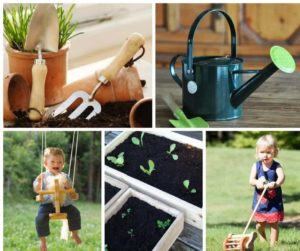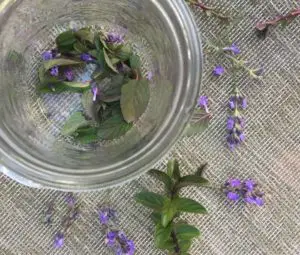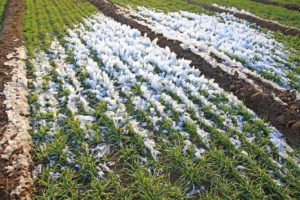Growing spinach indoors is easy to do all year-round. Plant spinach in a container and place it in a cool spot that gets four to six hours of sunlight per day, and you will have healthy spinach six weeks later.
Here’s how to grow spinach indoors:
- Place the seeds in water for one day, a week before planting
- Remove the seeds from the water after 24 hours and store the seeds in an airtight container in a cool spot for one week
- Fill a pot with nutrient-rich soil and plant the seeds ½-inch deep in the soil. Ensure that the pot has sufficient drainage holes at the bottom
- Water lightly every three to four days to keep the soil lightly moist
- When the seeds start sprouting, add some fertilizer to the soil
- Harvest the spinach six weeks later
How to Grow Spinach Indoors (Step-by-Step)
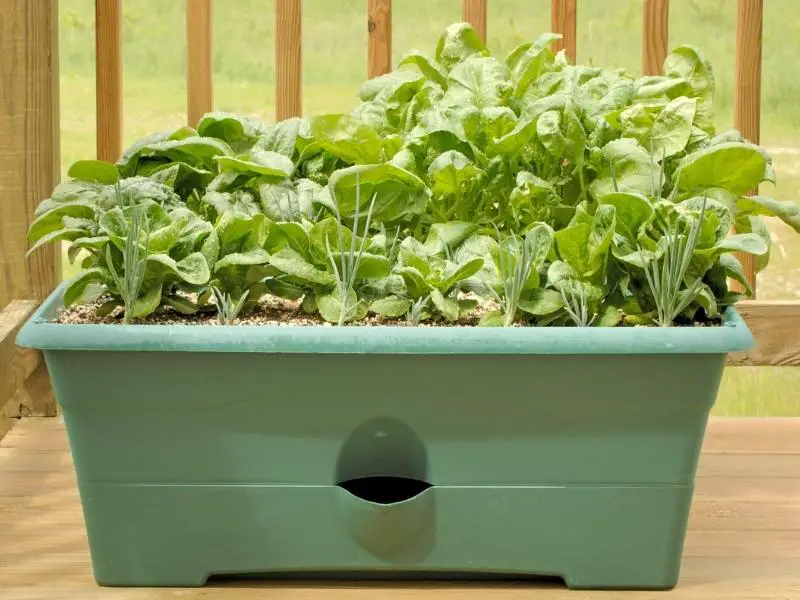
You need the following equipment to grow spinach indoors:
- A suitable pot or container
- A trowel
- Good-quality potting soil
- Spinach seeds
Spinach thrives in cool conditions with limited sunlight. Select the right spot to grow spinach successfully, and follow these easy steps:
Prepare the Seeds
Prepare the seeds one week before planting by soaking the seeds in a glass of warm water for 24 hours. Moistening the seeds in this way encourages germination once the seeds have been planted.
Remove the seeds from the water after 24 hours and dry them gently with a clean cloth or paper towel. Store the seeds in a sealed container in a cool place for one week.
Choose the Right Pot
Spinach needs a roomy pot. Select a large pot that is at least 8 inches deep and big enough to plant the seeds 3 inches apart. Drainage holes at the bottom are essential to prevent root rot.
Select the Best Position
Spinach does well in a cool spot that gets four to six hours of sunlight per day, with a temperature of 40–75°F. Hotter temperatures or longer exposure to direct sunlight causes the spinach plant to wilt.
If you don’t have a spot with natural light, you can plant spinach indoors with an LED light. Initially the young seedlings need 13–15 hours of light per day, and as the plant matures this can be reduced to eight to 10 hours per day.
Prepare the Soil
Fill the pot with good-quality, loamy potting soil that is rich in nitrogen and organic matter. The soil should be well-aerated to allow for good drainage, and the pH should be neutral.
Plant the Seeds
Place the prepared seeds on the soil, 3 inches apart. Cover the seeds with ½-inch layer of soil. Water lightly to dampen the soil.
Water Regularly
Water the soil lightly every three to four days. Keep the soil lightly moist, but avoid saturating it.
Excessive watering keeps the roots wet and causes root rot. Don’t water the leaves. If the leaves remain wet they can develop mildew, which is a fungal infection. If you find yourself too busy and caught up with everything in your life, you can try self-watering planters to ensure the soil stays lightly moist.
Fertilize
Once the seeds start to sprout, add some fertilizer or manure to the soil to nourish the spinach plant. Follow the instructions on store-bought fertilizer packs.
Watering with manure tea or using liquid fertilizer are good ways to add nutrients to the soil. For best results fertilize again after three weeks.
Mulch
Mulching with organic matter helps to retain moisture and adds nutrients to the soil, encouraging healthy growth.
Place a thin layer of mulch around the base of the spinach plant. Avoid using too much mulch. Over-mulching traps moisture and keeps the roots too wet.
Harvest
Spinach is ready to harvest when the plant has at least six leaves, each of which should be four inches long. Don’t wait for flowers to appear, because the leaves develop a bitter taste once the plant starts to flower.
Cut the individual leaves with clean, sharp scissors. New leaves will soon emerge. Alternatively, cut the entire plant at the base of its stem. The plant will regrow.
Types of Spinach for an Indoor Garden
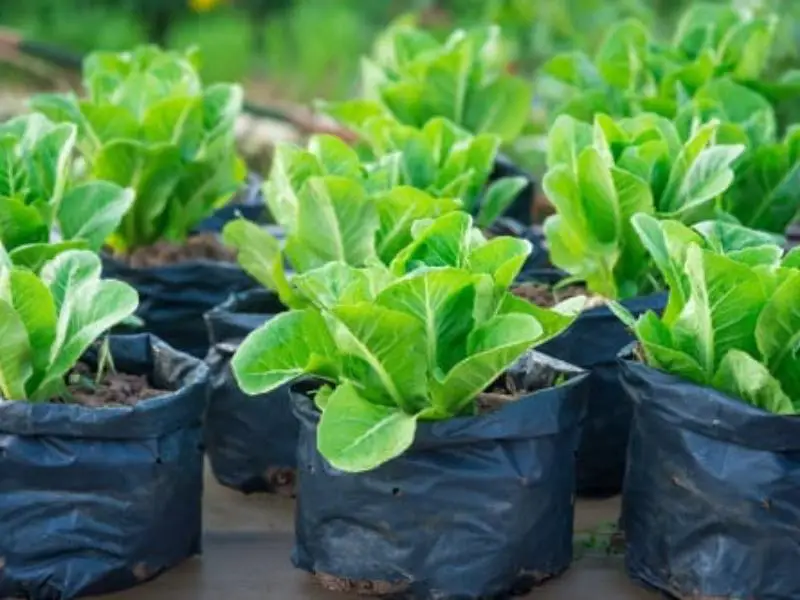
There are three main types of spinach that are suitable for an indoor garden:
Savoy spinach
Also known as curly leaf spinach, this variety has dark green wrinkled leaves with a crispy, crunchy texture.
There are two main varieties of savoy spinach, namely regiment spinach and Bloomsdale spinach. Regiment spinach is more suited to growing indoors because it grows more quickly than Bloomsdale spinach, but both types yield good results.
Both varieties of savoy spinach are ideal for planting in a cool climate.
Semi-savoy spinach
There are four main varieties of semi-savoy spinach, namely Teton, Catalina, Indian summer, and Tyee. These are rugged and hardy plants that resist diseases, making them the most suitable types for growing indoors.
Smooth-leafed spinach
Smooth-leafed spinach is easy to grow indoors, and is the ideal type of spinach for canning and freezing because it is a fast grower with a high yield.
Benefits of Growing Spinach Indoors
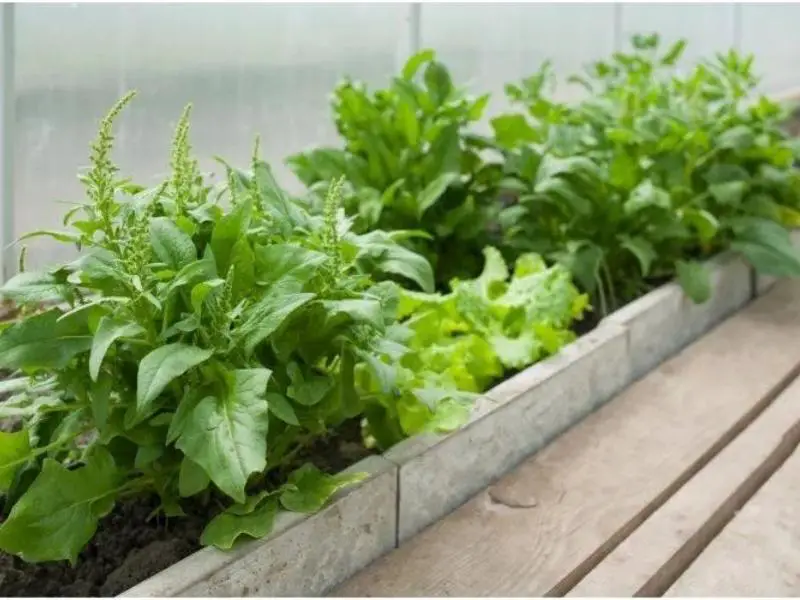
One of the main benefits of growing spinach indoors is that the process is easy and the results are satisfying. But there are also other benefits to growing spinach indoors:
No Garden Needed
Growing spinach indoors is a great way for those without a garden to enjoy the benefits and satisfaction of home-grown veggies.
No Seasonal Limitations
Growing spinach doesn’t have to be restricted by seasons. When growing spinach indoors, you can plant seeds at any time of the year and have a constant supply of spinach all year round.
Easy Maintenance
Growing spinach indoors makes caring for your spinach plants easy. You can control the amount of light that the plant receives, ensuring that it gets just the right exposure to ensure healthy growth.
Spinach that grows indoors isn’t subject to the ravages of extreme winter temperatures or the blistering heat of intense summers. Controlled exposure to heat and cold assures your spinach plant healthy growth.
Easy Harvesting
Harvesting just as much spinach as you need is easy when the plant is indoors. No need to go out into the cold to cut some spinach for dinner.
Health Benefits
Eating spinach has multiple health benefits, including:
- The high potassium content in spinach reduces blood sugar
- Spinach is rich in vitamin K, which supports good bone health
- Spinach is high in fiber and low in calories, making it a healthy food choice for those trying to lose weight
- The antioxidants in spinach help to protect the eyes from cataract growth, while the high vitamin A content promotes healthy mucus membranes in the eyes
- Spinach contains high levels of vitamin C and helps to protect against hypertension, or high blood pressure
- The antioxidants in spinach have anti-inflammatory properties, protecting against arthritis, headaches, and other inflammatory conditions
Troubleshooting & Tips for Success

How to Store Spinach
Remove the stems from the leaves and wash the leaves well. Dry the leaves and place them in an airtight container or zip lock bag.
Place a dampened piece of paper towel on top of the spinach leaves and seal the bag or container. The spinach will keep fresh for up to two weeks in the fridge.
How to Freeze Spinach
Fresh spinach can be frozen and stored in the freezer for up to three months. To freeze raw spinach, place spinach leaves in a blender or food processor with a few drops of water.
Blend the spinach to a smooth paste. Freeze the paste in ice cube trays, and add the frozen spinach to soups, stews, and smoothies.
How to Regrow Spinach
When harvesting spinach, cut the leaves to within 2 inches of the base of the plant, using sharp, clean gardening shears.
Take care not to damage the plant by cutting into the growing point. Add some fertilizer to the soil and water every three to four days. The plant will grow new leaves and within four weeks the spinach will be ready for harvesting again.
Dealing With Pests and Diseases
When watering spinach, don’t water the foliage. If the leaves remain moist they are likely to develop a fungal infection such as mildew. Fungal infections are difficult to eradicate, and you won’t be able to eat the affected leaves.
Growing spinach indoors helps to keep insect infestation at bay, however aphids do sometimes take hold and attack indoor spinach plants.
The best way to protect indoor spinach plants against aphids and other insects is to grow dill or chamomile in between the spinach, or nearby. Dill and chamomile contain natural properties that repel insects.


